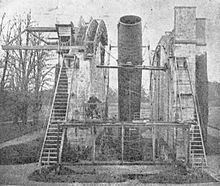 Andrew began his presentation (which thoughtfully incorporated a drinks interval!) with the story of his serendipitous find on a market stall some years ago: a box of "magic lantern" slides. Already fascinated with the moon and stars as a youngster, the first part of Andrew's talk took us back to the pioneering days of photography, telescopy and of course astronomy, which like much of Victorian Science was the pursuit of the wealthy gentlemen. Andrew stressed the parallel development of photography itself with that of astronomical telescopes. Names including Henry Fox Talbot (HFT) who would file and defend many patents relating to the chemistry of reproduction (see the famous long exposure calotype, top right, in which HFT appears in several positions in the same scene!).
Andrew began his presentation (which thoughtfully incorporated a drinks interval!) with the story of his serendipitous find on a market stall some years ago: a box of "magic lantern" slides. Already fascinated with the moon and stars as a youngster, the first part of Andrew's talk took us back to the pioneering days of photography, telescopy and of course astronomy, which like much of Victorian Science was the pursuit of the wealthy gentlemen. Andrew stressed the parallel development of photography itself with that of astronomical telescopes. Names including Henry Fox Talbot (HFT) who would file and defend many patents relating to the chemistry of reproduction (see the famous long exposure calotype, top right, in which HFT appears in several positions in the same scene!).
Using the images from his "prized" magic lantern collection, Andrew gave us a whistle stop tour of the instruments that have provided us with some of the earliest images of the planets, their moons and the more familiar features of the "heavens". Most of the early slides were actually drawings transferred onto the glass slides taken from observations on telescopes The telescope shown right was famously assembled by William Parsons York, the third Earl of Rosse. What I liked was Andrew's side by side comparison of early images with some of his own photographs. Andrew was at pains to point out the amazing quality of some of these historic observations despite the clockwork mechanisms of the telescopes, compared with modern electronic tracking technology.
Andrew introduced us next to the systematic and scientific approaches to astrophotography practised for example by E.E. Barnard who used the University of Chicago's 40" telescope at the Yerke's Observatory to produce early high resolution images of the milky way, comets (LHS), eclipses etc. Again, Andrew used the comparative images from "then and now" to share his enthusiasm and respect for these early pioneers of astrophotography. I was impressed by the extraordinary expert knowledge of the Widnes SciBar audience who were able to identify many astronomical landmarks from Andrew's slide show!
 The second half of Andrew's presentation included detailed insights into the tricks of the trade and he showed many breathtaking images of the moon, sun spot phenomena, and much much more: I couldn't possibly do justice to Andrew's enthusiasm, knowledge and the beauty of his images. However, I hope I have managed to convey the impression of an evening fuelled by passion and enthusiasm for astronomy and I wish him and Sue well in their new venture in France. Our loss of his energy and commitment to the Knowledge Observatory will surely be Limoges' gain!
The second half of Andrew's presentation included detailed insights into the tricks of the trade and he showed many breathtaking images of the moon, sun spot phenomena, and much much more: I couldn't possibly do justice to Andrew's enthusiasm, knowledge and the beauty of his images. However, I hope I have managed to convey the impression of an evening fuelled by passion and enthusiasm for astronomy and I wish him and Sue well in their new venture in France. Our loss of his energy and commitment to the Knowledge Observatory will surely be Limoges' gain!
